|
"The most beautiful and most refined of all known
modern photomechanical reproduction techniques is the photogravure."
S.Gottlieb, Ausübung der Heliogravüre,
1905
The technique of photogravure is an old printmaking
technique for transferring photographs to a copper plate. The plate
is laminated with a light-sensitive layer of gelatine, which after
being exposed with a positive can be removed selectively. The plate
is etched in several etching bathes of different concentrations,
generating finest grey tones without requiring a raster structure
of the used photograph.
Photogravure makes it possible to combine the realistic reproduction
of a photograph with the aesthetical appearance of an intaglio.
The nuances of grey tones are outstanding and can be achieved in
this quality only by the technique of collotype printing.
The technique combines the possibilities offered by photography
and printmaking with almost no limitations.
.
History
The development of photogravure is closely linked
to the beginning of photography. When in the first half of the 19th
century in all Europe many people were doing research about the
principles of photography, the preliminary stages of photogravure
were developed as well.
Initial successful attempts were accomplished by the French Joseph
Niepce in the 1820ies, who already laminated light-sensitive layers
of asphalt - dissolved in petroleum - onto pewter plates, which
could later be exposed, etched and printed.
In 1840 Grove published a technique to prepare Daguerre plates for
etching and printing.
The Englishman Talbot developed a procedure which made it possible
to laminate light-sensitive silver-based gelatine onto plates, which
were exposed and etched with the help of an aquatint grain in acid
bathes of different concentrations (patent in 1852).
Mungo Punton played a substantial part in the invention of photogravure.
Already in 1839, at the same time when photography was invented,
he published his research results about light-sensitive solutions
of dichromate on organic substances as gelatine and egg white. In
1854, Pretsch (Wien) and Poitevin (Paris) were the first who, almost
synchronistically, used dichromatic salts as photogenetic substances
in combination with macerating gelatine to create heliographic plates.
Karl Klic (Austria) is seen as the inventor of heliogravure
(1879). He combined Talbots procedure with a technique invented
by the Englishman Swan, which is using pigment paper in the process
of photographic transfer (Klic, born 1841, studied art at the Academy
of Fine Art in Prag. He came to know photography while helping his
father to establish a photo studio. In 1867, he worked in Pest as
a drawer with chemical ink for etching, from 1873-74 he was working
at the Vienna Etching Factories [Wiener Ätzanstalten], according
to Eder).
In the first years of photography there were two essential problems
for reproducing editions:
a) the durability of original photographs regarding tones and materials
and
b) the qualitative reproduction of big editions.
The photogravure solved that problem by making
it possible to print the editions in intaglio with rapid presses.
Soon this procedure gained more and more importance and was used
in various modifications.
Technique
For the transfer of a photograph, a positive is
required. Before transferring a usable negative to a copper plate,
one has to create a half-tone positive of the same size in the dark
room.
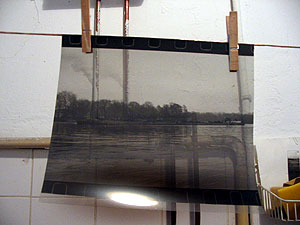
The half-tone positive
In the classical manner of aquatint, an aquatint
grain is applied to the copper plate (or the carrier material, the
pigment paper, is exposed to an aquatint screen). The pigment paper,
a paper laminated with gelatine, is made light sensitive by bathing
it in a chromate bath (2-3% of potassium dichromate - highly toxic).
After drying, the photopositive and a grey scale are exposed onto
the pigment paper.
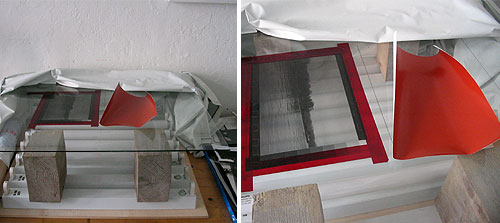
Exposure unit with UV-light -on the left the positive
with the grey-scale, on the right the pigment paper, which is pressed
onto positive and grey-scale during the exposure
To transfer the exposed pigment paper to the copper
plate, it is soaked in a tray of water. The macerating layer of
gelatine on the pigment paper is fixed on the plate with a roller.
After that, the plate is bathed in hand-hot water (40° C), and
the paper layer is removed carefully. The partial exposure of the
gelatine layer has made unexposed parts solvable, while the exposed
parts hardened and so got partly or completely unsolvable. This
way, the gelatine can be washed out gradually.
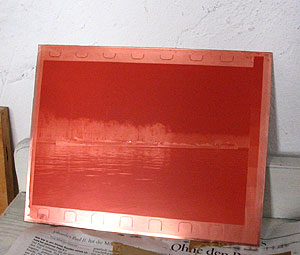
Developed plate
After drying, the plate is etched in several acid
bathes of different concentrations of ferric-chloride and water,
starting with the bath with the highest concentration. The more
water the acid contains, the more the gelatine macerates and thus
opens up more parts for being etched, so that the plate, according
to the different grey tones, is etched more or less deep, resulting
in finest grey tones.
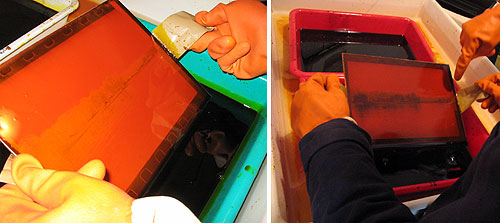
The plate in the acid bath:
On the left the first bath with the hightest acid concentration
On the right the last bath with the lowest concentration, where
the lightest tones are etched The process of etching is controlled
by watching the grey-scale.
After etching, the gelatine layer is removed from
the plate. The plate may now be printed.
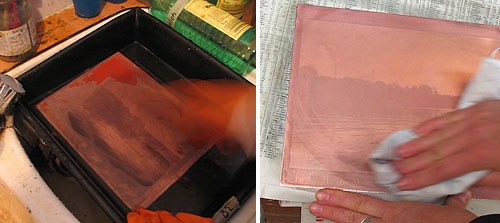
Removing gelatine remains and the aquatint grain
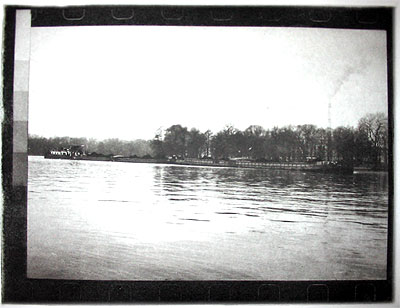
The finished print
Literature
Barnier: "Coming into Focus - a step by step
guide to alternative photographic printing processes"
Crawford: "Keepers of light - a history and
working guide to early photographic processes"
Eder: "Das Pigmentverfahren und die Heliogravure",
Halle, 1899
Eder: "Pigmentverfahren", Halle, 1926
Gottlieb: "Praktische Anleitung zur Heliogravüre",
Halle, 1905
Heidtmann: "Kunstphotographische Edeldruckverfahren
Heute", Berlin-Verlag, 1978
Husnik: "Die Heliogravüre", Wien,
1888
Kempe, Fritz :"Kunstfotografie um 1900 in
Deutschland" (Ausstellungskatalog), 1982,
Kühn: "Die Technik der Lichtbildnerei",
Halle, 1921
Morrish/MacCallum: "Copper Plate Photogravure",
Focal Press, 2003
Renger-Patzsch: "Das Tuschreliefverfahren...",
1912
Schuldes/Sprang: "Heliogravüre",
Ravensburger,1981
Spitzing: "Metallätzen nach Fotos",
Frech Stuttgart, 1973
Stieglitz: "Camera Work", Taschenbuchverlag
Volkmer, Ottomar: "Die Photo-Gravure...",
Halle 1895
Many thanks to Georg Thunert for his contribution
to this article.
|